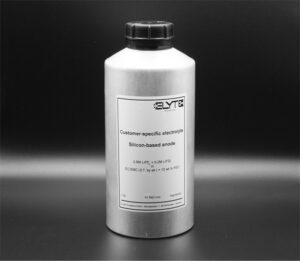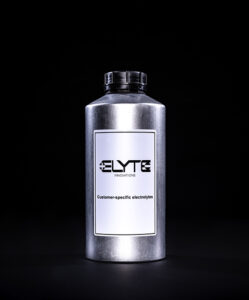
Electrolytes for high energy batteries
Specifications:
| Electrolyte salt | Combination of LiPF6 with lithium imide salts Plus appropriate co-salts depending on the application. |
| Solvent | Carbonate-based solvents i.e. EC, EMC, FEC Solvent type and composition is discussable upon application. |
| Example composition |
0.8 M LiPF6+ 0.2 M LiFSI dissolved in EC:EMC (3:7, w:w)+10% FEC |
| Batch sizes manufactory |
25 mL – 2.0 L bottles |
| Batch sizes production site | 20 L – 200 L barrels |
| Delivery time | maximum 14 days within EU Delivery times outside the EU on request. |
Packaging of our Electrolytes
| 20 L barrel | 200 L barrel | |
|---|---|---|
| Diameter [mm] | <=320 | <=600 |
| Height [mm] | <=530 | <=1150 |
| Net weight [kg] | ~8,5 | ~50 |
| Material (AISI) | 304 / 316L stainless steel | 304 / 316L stainless steel |
| Quick couplings | Nitto Kohki 1P for inert gas Nitto Kohki 2P for product Alternative couplings on request |
Nitto Kohki 2P for inert gas Nitto Kohki 4P for product Alternative couplings on request |
Drums per:
|
7 drums per pallet 12 drums per pallet 12 drums per pallet |
2 drums per pallet 3 drums per pallet 4 drums per pallet |
| Bottle (25 mL – 2.5 L) | Our electrolytes come in UN-certified aluminum bottles (made in Germany), which are wrapped in pouch bags sealed under an inert gas atmosphere. |
| Pouch bags | Shipped in UN-approved cardboard boxes suitable for the transportation of dangerous goods (in compliance with ADR). |
Electrolytes for high energy batteries
Characteristics
Silicon is currently considered as the most promising negative electrode material for next-generation high-energy lithium-ion batteries due to its high volumetric (9786 mAh cmSi-3) and gravimetric capacity (3580 mAh gSi-1) on the electrode level besides its economic feasibility and abundance. The major obstacles hindering the practical application of Si negative electrodes are the insufficient cycle life caused by enormous volumetric changes of Si electrode and continuous breakage/reformation of the solid electrolyte interphase in every cycle due to continuous decomposition of electrolyte on the Si electrode.
Application fields
Our electrolytes for silicon-based negative electrodes are designed to enable an extended cycle life via formation of a highly efficient solid electrolyte interphase, which is flexible enough to withstand the expansion/shrinkage of the silicon particles, significantly reducing the irreversible consumption of lithium (Li+) ions and the electrolyte. The electrolyte formulations contain optimized combinations of salt and solvent mixtures combined with film-forming additives that work synergistically. The electrolytes are suitable for pure silicon electrodes as well as silicon suboxides (SiOx with x≈1) containing electrodes and silicon/graphite blends.
